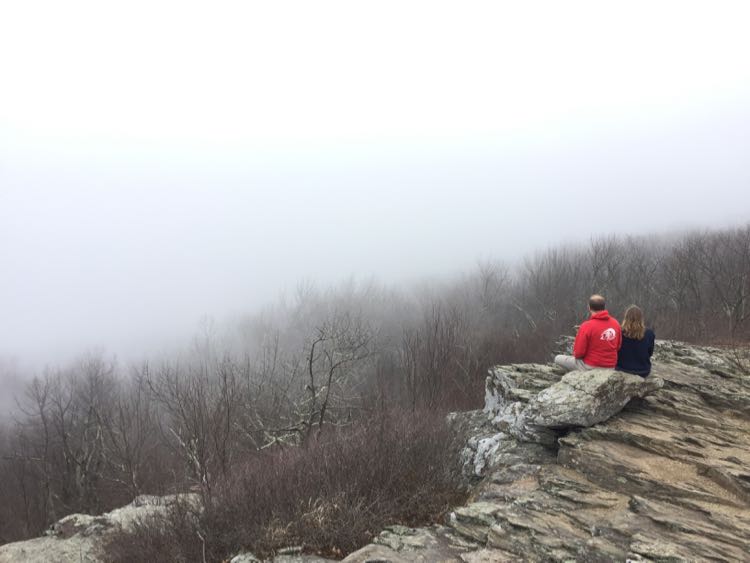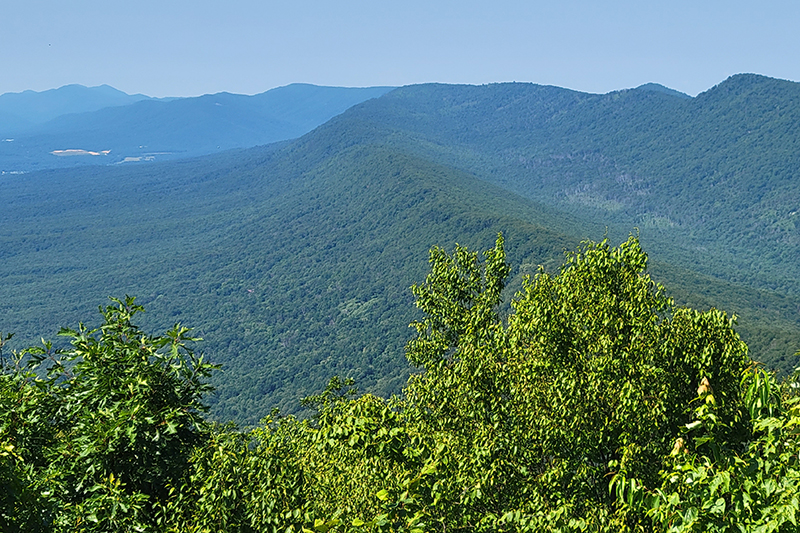

If you wish, you could end the hike here - this would make a worthy destination even if you didn't go any farther! Stay back from the edge - although it is not a cliff, per se, it's a steep drop over the side of the ridge right here. This is a great place to stop and enjoy a snack. On a clear day, especially during fall or spring, it's a spectacular vista, with Looking Glass Rock and the high Balsam Mountains to the far right, and further to the left, craggy John Rock and Cedar Rock Mountain with folds of ridges leading up to it. You might notice a short side path heading to the right, which leads to a good view to the southwest.

The trail goes downhill a bit and there will start to be some rocks in the path, although they're not too bad at first. Exposure to the elements and perhaps (in the past, at least) more frequent wildfires contribute to the changing nature of this forest on this steeper part of the ridge. Mountain Laurel and rhododendron begins to fill in the understory. The soil is rockier here and less rich than farther back on the ridge, and the trees start to get shorter and gnarlier. You'll start to notice how narrow the ridge becomes. As this happens, watch for a noticeable change in the vegetation.Īs you near the 1/2 mile point, the old road bed you've been following ends and the path becomes a purpose-built trail. Gradually, the ridge starts to steepen on either side of the trail. The trail remains nearly level at this point. The woods here are similar to the ones on the other side, and lots of ferns grow in between the trees. If you're quiet, you might see something here - perhaps a deer, rabbit, or groundhog.įollow the trail through the meadow, and exit into the woods on the other side. The meadow is kept open by the Forest Service by mowing, in order to provide habitat for wildlife that likes open, grassy areas - or those that like to live near the edge of such openings. The climb is not very difficult, and after about 1/4 mile it levels off before entering an open meadow on top of the ridge. Sections of the woods are open, with the ground covered by grass and ferns.

The rocky old road begins a short climb through some young woods, with lots of vines growing in the trees. A sign for the Bennett Gap trail stands beside the old roadbed, which is now a trail. Details Hike Description Lush spring green ferns along the Ridgewalk Best Hikeīegin the hike behind the metal gate. The Bennett Gap trail will then be on your right. The section of FS 477 from the trailhead north to its other junction with US 276 may be in better shape - use a map and come south on FS 477 from that direction if you're unsure about your vehicle. (Don't be confused by some other old roads leading off to the left in the same vicinity as the Bennett Gap Trail - it is well used, signed, and blazed, so you'll know it when you're there).įS 477 can become somewhat rough between periods of maintenance, and may be tricky to navigate with an average passenger car at times - though it's usually not impassible. There is parking for 4-5 cars on the right. The Bennett Gap trail starts on the left just before the top of the mountain at an old gate. Follow 477 for about 4.8 miles (it's twisty and narrow in places) uphill. Go 2.3 miles and turn right on gravel FS 477. At the intersection with US 64/276, turn right onto US 276 and enter the Pisgah National Forest. Take exit 40 for the Asheville Airport/NC 280 and turn right (south) Follow NC 280 for 16 miles, through Mills River to Brevard. From Asheville, take I-240 west to I-26 east.


 0 kommentar(er)
0 kommentar(er)
